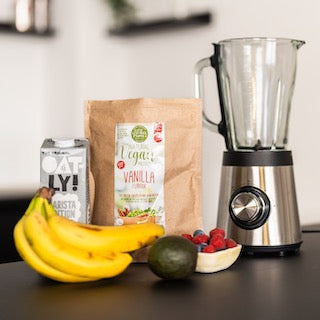The 10 percent rule in Running - Jermain Breidel
 I am Jermain Breidel, running coach at Vondelgym and captain of the Patta Running Team in Amsterdam. In addition, I am a long distance runner. In the near future, I will be providing you with running tips to help you get started running and training more efficiently. In this second edition, we will talk about the 10 percent rule.
I am Jermain Breidel, running coach at Vondelgym and captain of the Patta Running Team in Amsterdam. In addition, I am a long distance runner. In the near future, I will be providing you with running tips to help you get started running and training more efficiently. In this second edition, we will talk about the 10 percent rule.
The 10 Percent Rule in Running.
This safe, easy-to-follow method will help you increase your mileage in a healthy way.
The 10-percent rule is one of the most important and proven rules in running. This rule assumes that you should never increase your weekly distance by more than 10 percent than you ran the previous week.
Overload

Suppose you have been running 25km a week recently. For some reason - perhaps you want to prepare for an upcoming race or you just feel you're ready - you decide to increase your training distance and frequency. Instead of running three times a week, you manage to run five times. Your training increases from 25km per week to 45km per week, an increase of up to 80 percent.
The week of the race you begin to feel pain in your knee while running. In fact, by Saturday it is so bad that you can barely walk normally. You can't deny the symptoms and realize you won't be able to run the Sunday morning race. You have a knee injury.
The 10 percent rule is so important for this very reason. Because the vast majority of running injuries are overuse injuries. These injuries occur when you run too much or increase your weekly training program too quickly.
Temper your enthusiasm
For runners, the biggest enemy is often their own energy and enthusiasm. You feel great, so you think you can handle longer distances and multiple workouts. Whether it's because a friend has challenged you to participate in a race, everyone in your department at work has decided to get in shape for an upcoming charity run or perhaps because you've been caught by the marathon bug. Such events are great motivators, so plunge enthusiastically into training.
Gradual adaptation to stress
Great - except for one thing; your body doesn't share your enthusiasm. It follows a simple, immutable principle: gradual adaptation to stress.
The gradual adaptation principle is one of many examples of the body's cleverness. Without that cleverness, no one could ever climb Mount Everest, swim the English Channel or run a marathon. As a result, there are almost no limits to what you can achieve. But you can't bend the rules because your body breaks and you get an injury, get sick or suddenly get very tired.
How it works.
However, if you follow the 10 percent rule, your body will gradually get stronger and fitter. If you run 10 km a week now and want to increase your training, run 11 km next week, 12.1 km the week after that and 13.2 km the following week. This may seem like a slow pace in terms of progress, but in just 8 to 10 weeks you could be running 20km a week.
Continue at that pace and eventually you will be running 40km per week in just four months after you start building up from 10km. And 40km a week, believe me, that's a lot of running.

Conclusion
Don't build it up too fast, temper your enthusiasm, make a schedule and work slowly towards your end goal. While running, you almost always win if you follow the path of gradual progress.
Also read:
- THE IDEAL STRIDE FREQUENCY WHEN RUNNING!
- ROAD TO MARATHON! WITH JERMAIN BREIDEL
- ROAD TO MARATHON! SETBACK, INTERVAL AND FARTLEK
- PROTEINS AND ENDURANCE SPORTS, DO THEY GO TOGETHER? YES IT DOES!
For more sports related knowledge and interesting articles you can check out our blog here.
















